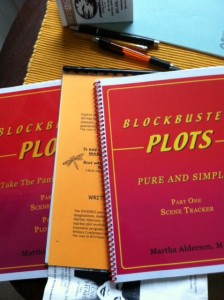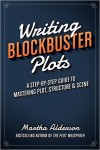 The evolution of my first plot book from indie published to traditional began twelve years ago as spiral-bound handout for students in the University of California at Santa Cruz writing program extension. I shared what I was discovering about plot while researching and analyzing stories to improve my own fiction writing.
The evolution of my first plot book from indie published to traditional began twelve years ago as spiral-bound handout for students in the University of California at Santa Cruz writing program extension. I shared what I was discovering about plot while researching and analyzing stories to improve my own fiction writing.
The visual approach I created to teach plot and for creating plots appealed to more and more writers who expected more and more information. Suddenly I was teaching more and writing less. Handouts and templates and lectures went from spiral bound to an actual indie book. The hope was that the book would free up time for my own writing. That didn’t exactly happen and for reasons that always ended up sounding more like excuses.
Writing what started out a guide to creating plot planners and scene trackers for writers planning and envisioning their stories, I often escaped my writing cave resolved to slow down, sure I needed more time to finish what started out as Blockbuster Plots Pure & Simple and is now Writing Blockbuster Plots: A Step-by-Step Guide to Mastering Plot, Structure & Scene I never got very far before my husband chased me back inside. Write the book. Get something out there. See what happens, he kept saying. If it sticks, stick with it. If not, move on. I’ve gratefully followed his advice ever since.
Rather than free up time for my own fiction writing, the evolution of a book from indie to traditional demanded decisions and expert cover designers, formatters, editors and indexers (services that are readily available today that weren’t 12 years ago. Simply the idea of self-publishing back then was looked down upon and regarded as less than the quality, appearance and content of a traditionally published book. How times have changed!), printers willing to use recycled paper and then dealing with distribution and shipping once the book was ready to greet the world.
Baker and Taylor carried the book but the vast majority I hand sold “in the back of the room” at my plot workshops and conferences bookstores and on-line. I formed my own publishing company (Illusion Press) and published Blockbuster Plots before I even had a website or much on-line experience, preferring the library at the time to the internet (again, how times have changed, and so quickly). I set up shop just as people were opening up to the idea of buying on-line from individuals. Instructional DVDs followed and a Scene Tracker Kit.
A few years later, Adams Media, a traditional publisher, paid me an advance to write The Plot Whisperer: Secrets of Story Structure Any Writer Can Master. The first-hand experience in every aspect of independent publishing and selling a book gave me a true appreciation of how much my publisher was doing for me to earn their hefty percentage. Overjoyed to let go of all the details, I anticipated all the time I’d have finally for my own fiction writing.
Instead, more books, sold-out workshops, DVDs turned into on-line video courses and plot consultations followed.
This year, Writers Digest is publishing Writing Blockbuster Plots: A Step-by-Step Guide to Mastering Plot, Structure & Scene. As they explain on the Amazon sales page: Writing Blockbuster Plots began life as a self-published book back when Martha Alderson was first developing her brand as a teacher in 2004. At that time, as we know, self-published books were mainly created for back of room sales during conferences, etc, rather than bookstore or online distribution.
In the time since publishing that first book, the Blockbuster Plots brand has expanded to encompass plot workshops, one-on-one plot consultations, and a free monthly newsletter.
We, and the author, feel that it’s time to relaunch Blockbuster Plots as a book, now that her profile is so much higher, particularly given her track record with The Plot Whisperer. In discussing Blockbuster Plots, it’s important to note how it’s different from The Plot Whisperer.
TPS takes a much more “touchy feely” approach to the discussion of plot. That works for some people, but for others it does not. In fact, one of the most common criticisms of TPS in various reader reviews is that the book doesn’t include enough hardworking, how-to information about plot development and story structure.
Blockbuster Plots, alternatively, is completely devoted to the nuts and bolts of those two elements of fiction. The author has designed the book specifically to demystify how story works. She shows writers how to track the seven most important elements of a scene on a Scene Tracker, and how to use the Plot Planner to develop a multi-layered plotline for each individual project. Alderson also analyses scenes written by classic and contemporary writers such as Twain, McCarthy, London, Fitch, Chopin, and Letts, which helps show writers how to: * Pre-plot * Link scenes through cause and effect * Determine which scenes are flat and why * Set up tension, conflict and suspense * Develop complex characters * Establish compelling action * Re-vision your rewrites * Clarify your theme * Deepen and expand your narrative.”
The evolution of WBP brings me to the release of the new and improved edition of my book and full circle. I look forward to a blog tour and book giveaway in celebration of the official launch the 2nd edition of what continues to embody me, my approach, teaching style and hopes and dreams for writers. Check back for details how you can win a book of your choice.
Now that WBP is legit, published by a truly traditional press, I give myself permission to devote all my time to my own fiction writing. Finally. No more excuses.
 Writing Blockbuster Plots
Writing Blockbuster Plots
A Step-by-Step Guide to Mastering Plot, Structure & Scene
For tried and true techniques that have helped hundreds of writers bring their story ideas alive, finish what they started and keep the big picture of their stories in mind at all times. Create an individualized Plot Planner for your novel, memoir, screenplay. Track your scenes for the 7 essential elements in every great scene.

 The Effective Use of Thematic Details
The Effective Use of Thematic Details
Follow Me!